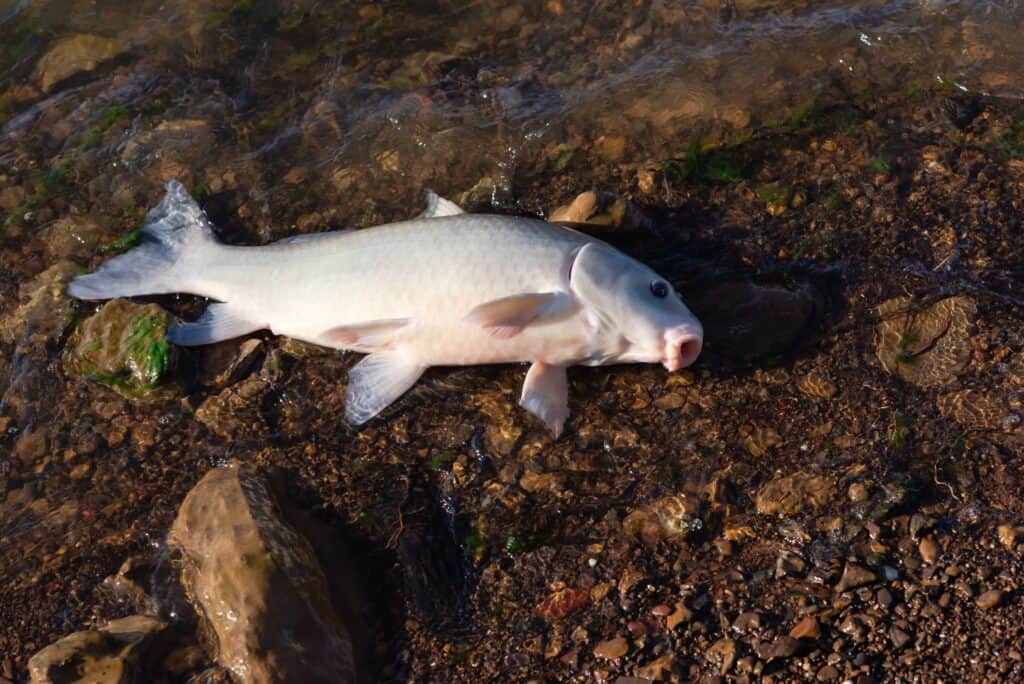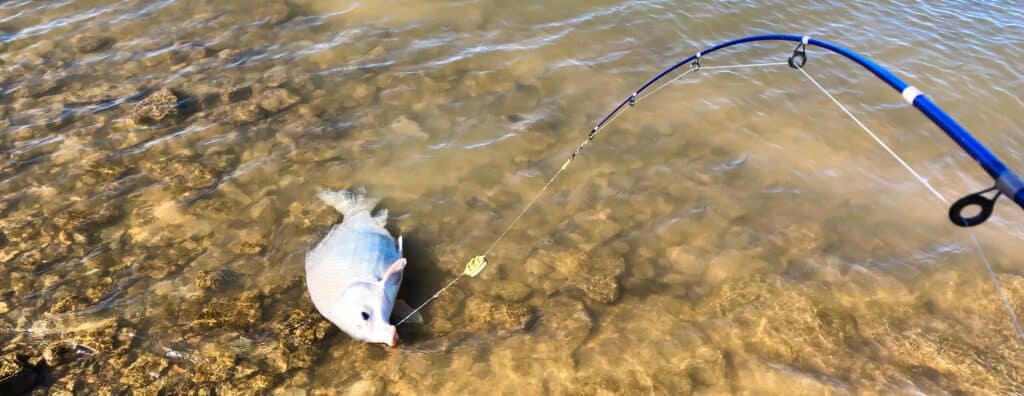Ohio is a fantastic place for anglers. After all, the state has the Ohio River on its eastern and southern borders, Lake Erie at its northern border, and several large lakes throughout its region. Many species of fish live in these waters, giving people a variety of options for the kind of fish they want to catch. Oftentimes, anglers want to catch the largest fish possible, like buffalo fish. Discover the largest buffalo fish ever caught in Ohio and see how it measures up to the world record for the species.

About the Buffalo Fish Species
Five different species belong to the Ictiobus genus, and they’re collectively called buffalo, buffalo fish, buffalo suckers, or buffalofish. The bigmouth buffalo fish (Ictiobus cyprinellus) is the largest and longest-lived member of its genus. These fish can reach sizes between 2 and 4 feet in length and weigh between 40 and 80 pounds. However, many members of the species do not reach such large sizes.
Some members of the bigmouth buffalo fish species can live for more than 100 years. Their long lives allow them to grow large in their freshwater habitats.
The genus as a whole is considered a type of suckerfish since they belong to the Cypriniformes order. They feed on just about any food that they can fit in their mouths. The bigmouth buffalo fish is a filter feeder, and it eats various small crustaceans such as larval zebra mussels, plankton, algae, and other foods like insects. The fish’s diet makes it challenging for anglers to catch on a hook and line.
The bigmouth species prefer to live in shallow areas in lakes, ponds, streams, and rivers. They’re known for surviving in places with low oxygen content.
These fish are sometimes confused for carp, but they have a distinct look. First off, the bigmouth buffalo has a sucker mouth. They also have a long dorsal fin that begins with a tall spine and tapers near the tail. The fish can appear bluish-silver, olive-grey, or olive with a coppery color on the top and sides. The fish are white on the belly.
The buffalo fish species can be tough to catch, but its size makes the effort worthwhile.

The smallmouth buffalo fish is one member of the
Ictiobusgenus.
©Trong Nguyen/Shutterstock.com
What Was the Largest Buffalo Fish Ever Caught in Ohio?
The largest buffalo fish ever caught in Ohio was 46 pounds 0.16 ounces, and it was captured by Tim Veit from Galena. He caught the fish at the Hoover Reservoir on July 2, 1999, a body of water northeast of Columbus. The massive buffalo fish had a total length of 42 inches. Veit used a hook and line to catch the fish. His record has stood in the state ever since he caught the massive fish.
The second-largest buffalo fish caught in the state weighed 43 pounds, measured 43.5 inches, and had a girth of nearly 29 inches. Josh Bowmar, a very aptly named man, caught this fish using a bow on May 21, 2018. An interesting point is that he also caught his record-setting fish in the Hoover Reservoir. That means both the hook and line record and the bowfishing record for the buffalo fish both came from this one body of water.
Bowfishing is a popular fishing method used for buffalo fish. They can be somewhat picky eaters, and the bigmouth buffalo fish are filter feeders. As a result, some types of bait simply will not work on them.

Anglers enjoy fishing for buffalo fish, as they are challenging to catch, and great to eat.
©Trong Nguyen/Shutterstock.com
Where Is Hoover Reservoir?
The Hoover Reservoir is located in Franklin County, Ohio. This county is near the center of the state. The reservoir is located about 10 miles northeast of downtown Columbus. The Hoover Dam, not the enormous one, impounds the Big Walnut Creek, creating the reservoir.
The Hoover Reservoir is a very popular fishing area for people in the region. The reservoir has a total surface area of 3,272 acres, a lot of space to find a good fishing spot.
Buffalo fish are not among the most popular fish to catch in the lake, though. Instead, the Hoover Reservoir contains many other species of fish. The reservoir is a popular place to fish for catfish. Some of the fish people catch in this lake include:
- Blue catfish
- Flathead catfish
- Channel catfish
- Black crappie
- Bluegill
- Largemouth bass
- Smallmouth bass
- White bass
- White crappie.
Any angler that wants to try their luck at this lake has a wide assortment of fish available to them. While the reservoir does contain buffalo fish, they’re somewhat challenging to get on the line due to their diet.
Is Ohio’s Largest Buffalo Fish the Biggest in the World?
No, the largest buffalo fish ever caught in Ohio was not the world record for this species. Currently, two claims exist for the biggest buffalo fish ever caught.
The first record comes from the International Game Fish Association. This group claims that the largest bigmouth buffalo fish ever caught in the world weighed 70 pounds 5 ounces. Delbert Sisk caught the fish in Bastrop, Louisiana back on April 21, 1980.
Another source claims that a 76.5-pound bigmouth buffalo fish was caught in Wisconsin in 2013. The angler, Noah LaBarge, was just 12 years old at the time, and he caught the fish in Petenwell Flowage. The 76.5-pound fish might be the largest member of the species ever caught. However, the International Game Fish Association does not recognize the record.
The largest buffalo fish ever caught in Ohio was a very large specimen, but it was not among the largest ever caught. Still, the record-setting fish for both the hook-and-line record and the bowfishing record came from the same place, Hoover Reservoir. These fish live for a very long time, so their longevity may contribute to their record-setting sizes.

Bowfishing is a popular fishing method used for buffalo fish.
©Christopher Moswitzer/Shutterstock.com
The photo featured at the top of this post is ©
Thank you for reading! Have some feedback for us? Contact the AZ Animals editorial team.






